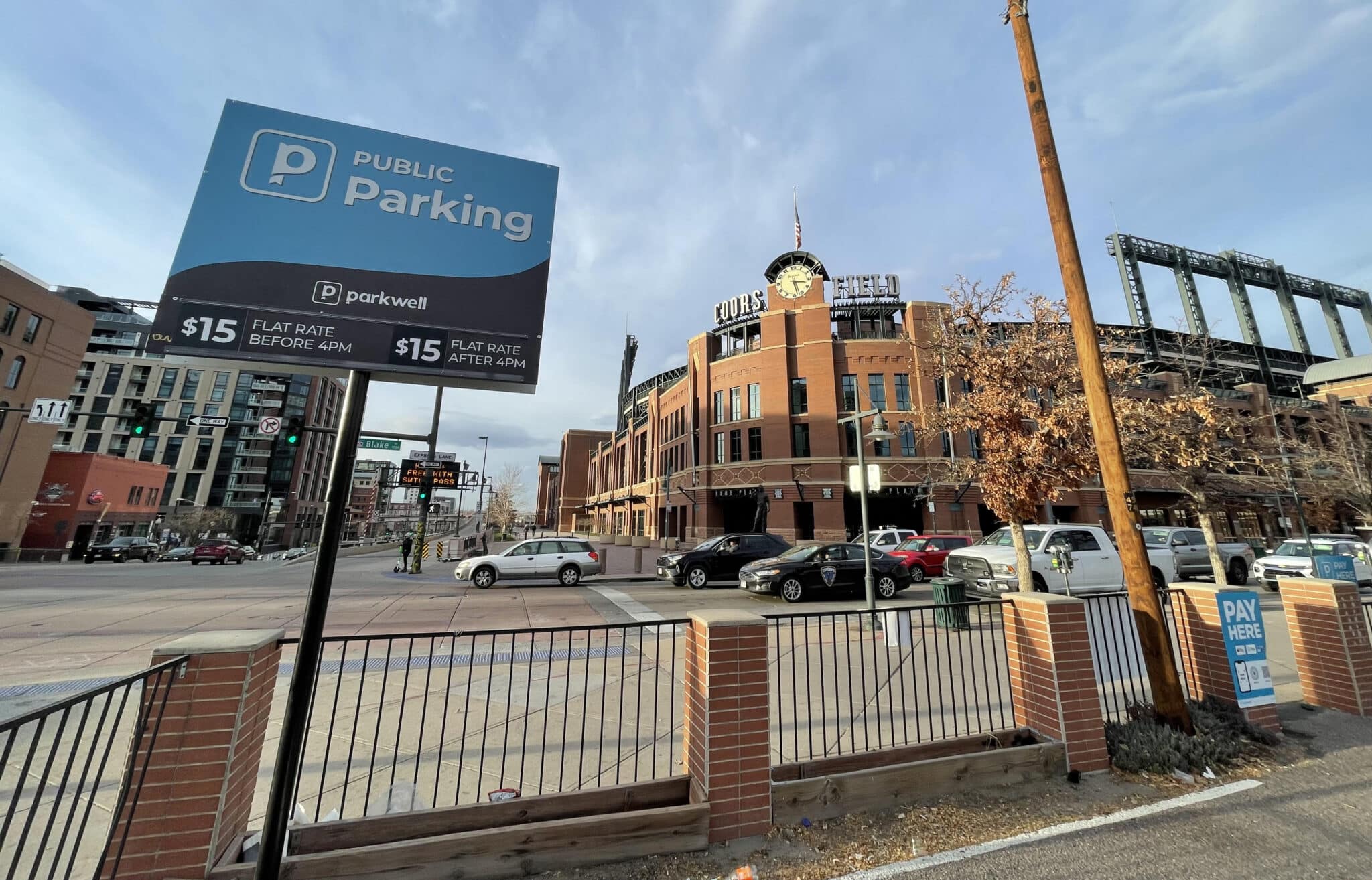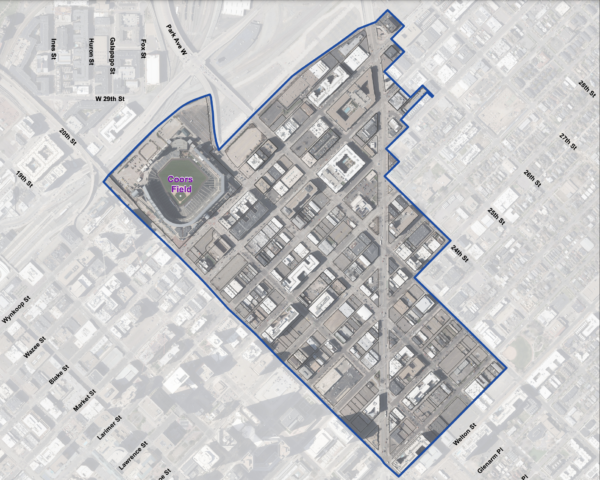
Looking at Coors Field from the parking lot at 2000 Blake St. (BusinessDen file)
Patrick McMichael lives and owns a business in Denver’s Ballpark neighborhood. Sitting in a coffee shop with a BusinessDen reporter, he points to the injury he received protecting a neighbor’s property on Larimer Street from a homeless person.
“As you can see from my lip, last Friday night, I just got clocked right in the face,” he said.
McMichael, like some of his Ballpark peers, is working to organize what he thinks will prevent future incidents such as these: a General Improvement District.
“Making the neighborhood safer, it encourages more people to come visit the neighborhood … the Rockies last year, they were down 10 percent in attendance just because people were concerned about safety,” he said. (The Rockies did not respond to multiple requests for comment.)
A GID functions like a Business Improvement District. It works as a quasi-governmental neighborhood organization with its own budget and employees working to improve and secure the area. It is funded by a tax which all residents and property owners pay, unlike its business-only counterpart that taxes commercial buildings only.
The district would be bounded by Coors Field to the west and 20th Street to the south, with some spillover past Broadway to the north and east. It would fill in the hole in services that the neighborhood receives, given that RiNo to the north, downtown to the south and Five Points to the west all have business or general improvement districts of their own.
“I think over time, Ballpark was never really clearly defined as a “neighborhood.” It was just sort of on the periphery of everything else,” said Jamie Giellis, a former mayoral candidate who is working as a consultant on the GID creation process.
Currently, the Ballpark and Arapahoe Square neighborhoods are serviced by four “local maintenance districts,” or LMDs, created decades ago. Many residents don’t even know they exist, McMichael said. Their borders are outdated — some overlap — and funding, which comes from taxes assessed on individual parcels, amounts to about $323,000 annually across all four.
Next Monday, the Denver City Council will vote on whether or not to put the GID on the November general election ballot for Ballpark residents and property owners to approve or reject. It would replace the old LMD system, which could end up costing some in the neighborhood less in taxes, McMichael said.
“They’re not particularly strong in terms of their management. Their oversight is at the city public works level,” Giellis said. “They all have different budgets, they all have different things they do.”
A city LMD representative did not respond to a request for comment.
If voters approve the GID this fall, McMichael will be one of the initial 11 individuals tapped to serve on the district’s board. Other board members would include Jay Soneff, president of real estate consultancy Jamis Cos.; Marti Page, owner of landlord The Anchor Group, and Candice Pineda, owner of the Mexico City Restaurant & Lounge at 2115 Larimer St.
The board is designed to keep representation balanced. A seat has been reserved for a Rockies representative, a social service provider, the City Council member and the executive director of the city’s Department of Infrastructure and Transportation. At least one seat must be held by a residential property owner, commercial property owner and business owner.
Documents provided by GID organizers to BusinessDen include a planned budget of $1.3 million for its first year, though it’s expected to be more than that — closer to $1.7 million — with contributions from tax-exempt groups such as the Rockies and social service providers.
The largest chunk, $750,000, will go towards safety and security, which involves the hiring of “community ambassadors,” who work for the neighborhood.
“People in Ballpark polos and khaki shorts,” Giellis said. “They bring in security, homeless outreach, also the cleaning and maintenance side and the kind of community, front-facing hospitality side as well.
“Activity on the streets, more people on the streets, more things happening in and of itself is crime deterrence,” she said.
The social services in the neighborhood are on board as well, according to Giellis, whose consulting firm is Centro Inc. They don’t want their own clients “ to be confronted with threats and drugs and safety issues,” she said.
For years, the neighborhood dealt with large homeless encampments. These camps have mostly been cleaned up, though homelessness is an issue that persists.
As for the rest of the planned budget, there’s $300,000 for cleaning, landscaping and infrastructure projects, $100,000 for administration and management, and a few smaller line items such as $22,000 for reserves and a one-time, $85,000 estimated repayment for the costs of organizing the GID.
Its funding will come from a tax of $5 for every $1,000 of a property’s assessed value. Tax officials assess commercial spaces differently from residential ones, but it is always a percentage of the property’s worth.
Using an example with 2023 assessment values, a $1 million commercial property would be taxed $1,450 for the GID. A single family residential property with the same value would be taxed $335.
GID Tax Calculator
Please note: Residential assessment rates for 2024 have not been set yet. The calculations are based on the 2023 rates.
Find your property value here.
The GID would hire a full-time executive director to oversee its day-to-day operations. The role would be wide-ranging, from acting as a liaison between the city and the neighborhood, to coordinating the district’s services and working to establish a true neighborhood identity.
But for some, their support for the GID is far less technical and nuanced than that. For 38-year-old Stevenson Farnsworth, he woke up one morning to find the trees in front of his home being cut down by a contractor for his LMD.
“I was like: ‘Who are you, and what are you doing? I planted those!’” he said.
For the past five years, Farnsworth has been the treasurer of the LMD which services Broadway — a direct result of the tree incident, which was almost a decade ago. It’s a volunteer role, but now, he walks up and down the street watering the trees himself.
“With my wagons and my buckets,” he said. “You can see me. I usually have a beer because it’s manual labor and it usually takes a few hours.”
A CPA and residential real estate agent by trade, Farnsworth will be a member of the GID board should it pass in November, replacing his wagon and buckets with an actual water truck. He said that he personally hasn’t seen any organized opposition to the district, though that may change as election time draws near.
“We’ve never really had a sense of community, and this is it,” he said. “This will change the trajectory of our neighborhood for the better.”

Map of the proposed GID boundaries. (Courtesy ballparkdenver.org)

